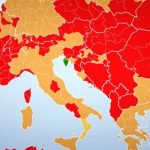
September 26, 2020 – The Belgian Ministry of Foreign Affairs has published a new list of countries by zones/colors according to the epidemiological situation. Istria and Varazdin are now on the green list.
HRTurizam reports that it is important to emphasize precisely the regional approach to travel restrictions, which in Croatia tourism entrepreneurs have been fighting for since the beginning of the COVID crisis, and the European Commission’s proposal is on that path.
Thanks to this approach, although most of Croatia is still in the red zone, according to the newly updated list – Istria and Varazdin are on the “green” list, thus enabling Belgian tourists to travel to these two regions.
Namely, the European Commission presented a proposal for Recommendations on a coordinated approach to restrictions on free movement in response to the COVID-19 pandemic, and the proposal identifies four main areas where close cooperation between the Member States is needed:
– common criteria and thresholds for the Member States to introduce travel restrictions
– mapping common criteria with an agreed color code
– a common framework for measures applicable to travelers from high-risk areas
– clearly and timely informing the public about all restrictions
Member States should provide data on new cases to the European Center for Disease Prevention and Control on a weekly basis and should also provide data for the regional level to ensure that measures can be targeted only in areas where it is absolutely necessary.
Recall, on Wednesday, Germany added regions from 11 European countries to the list of high-risk areas, including Lika-Senj County, rejecting the last hope of reviving tourism at a time when many countries are threatened by a second wave of coronavirus.
The Robert Koch Institute list includes major tourist destinations such as the French regions of Center-Val de Loire, Brittany and Normandy, Lika-Senj County in Croatia, and the Notranjsko-kraška region in Slovenia.
The list also includes the capitals of Ireland, Portugal, and Denmark, the Dutch province of Utrecht, the Austrian state of Vorarlberg, most of the Czech Republic, the county of Gyor in western Hungary, and Romania’s Covasna.
The inclusion in the list of risk areas usually follows when the Ministry of Foreign Affairs publishes recommendations against necessary trips to the region in question.
Germany warns against traveling to regions in the European Union where more than 50 are infected per 100,000 people per week.
Due to the spread of the epidemic, Germany has so far included Dubrovnik-Neretva, Požega-Slavonia, Šibenik-Knin, Split-Dalmatia, Brod-Posavina, Virovitica-Podravina, and Zadar counties on the list of epidemiologically risky areas in Croatia.
Declaring an area risky means that those returning from vacation must be tested for coronavirus and remain in self-isolation until they receive a negative test result.
For the latest travel info, bookmark our main travel info article, which is updated daily.
Read the Croatian Travel Update in your language – now available in 24 languages
Join the Total Croatia Travel INFO Viber community.











